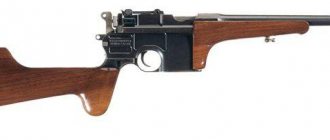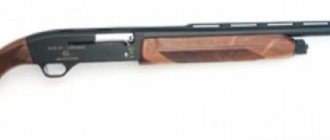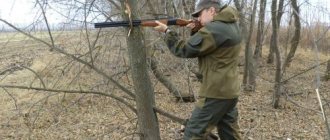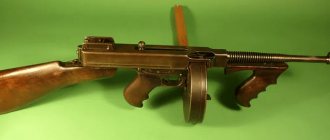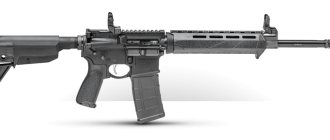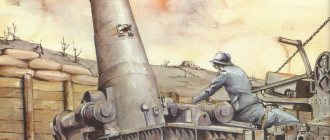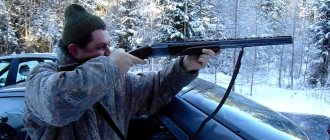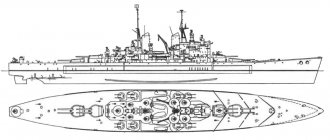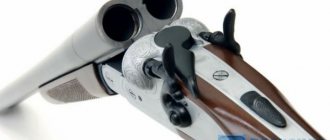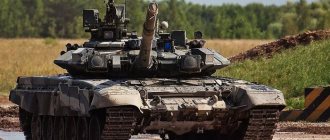The TOZ-54 model can easily be classified as “the last of the Mohicans”; this weapon not only has open triggers, but also a triple locking system. It was not produced for long: from 1974 to 78. It inherited from the legendary TOZ-BM unsurpassed survivability and unpretentiousness to operating conditions, and in terms of cost it was one of the cheapest hunting rifles in the USSR. Therefore, the specimens found on consignment sale have an extreme degree of wear.
Description of the gun TOZ-54
A hunting rifle with a horizontal, smooth barrel. It was produced for the most part in 12 gauge and with a chamber length of 70 mm. Models of caliber 28 and 32 with model index TOZ-50 are very rare. A distinctive feature of the design is the external triggers, which at the final stage of modernization of the TOZ-BM model lost their elegant shape and became more like angular hooks. The forend became just as rough and angular. In principle, this was the spirit of the times - in the early 70s they got rid of excessive decoration in everything, and not only in architecture.
By creating this model, the designers sought to increase the strength of the fracture and locking unit of the barrels. To do this, they strengthened the eye of the Greener bolt and made the seat of the release lever deeper. Only the breech coupling, into which the barrel tubes were pressed, was unified and simplified. Previously, this was done using the hot stretch method.
An overview of the TOZ-54 gun is given in this video:
Advantages and disadvantages
- It has been discontinued, and the samples found on consignment sale have an extreme degree of wear on the mechanisms, since the gun was “consumer goods” and was used without much reverence.
- External triggers allow you to keep cartridges in the breech indefinitely; this design of hunting rifles is the safest to use. However, it is somewhat inferior in rate of fire to shotguns with internal triggers.
- At the time of production, TOZ had the position of “barrel closer”, so the ballistic qualities of products from Tula were among the best in the USSR. For this reason, it makes sense to tinker with the restoration of completely “dead” triggers and cracked stocks.
- The triple locking system - Perdet bar and Griner bolt - ensures such reliable coupling of the barrel block with the butt and trigger that even a double excess of gunpowder in the cartridge case will not lead to rupture of the receiver. True, this is the case if you do not overdo it with the density of the wads.
The appearance of angular triggers and a beaver-tail-shaped forend may cause rejection among weapons aesthetes.
The gun was produced exclusively with wooden stocks. Walnut trees were extremely rare among them; most of them were beech trees. This wood is subject to severe warping when dried, so stocks with a helical bend are often found in forty-year-old specimens. At the same time, it is extremely dense, which is why the gun weighs more than three kilograms.
Photo TOZ-54
Purpose
A gun with constant choke (left barrel) and pay (right) muzzle constrictions, so it was used for feather hunting; hares and foxes were killed with it. Reliable triple locking allows you to fire a light sub-caliber bullet from the right barrel without the risk of bursting the receiver.
Varieties
Most of the guns were produced in 12 gauge with a 70 mm chamber. TOZ also had plans to produce 16 and 20 gauge. There is no information about whether such models actually exist. Models of caliber 32 and 28 had the index TOZ-50. The main difference was the design of the stock: in addition to the classic ones with a straight comb, stocks with a Bavarian cheekpiece and a Monte Carlo cushion were produced.
Tula double-barreled shotguns in the USSR before the appearance of TOZ-54
In the USSR, after the revolution, traditional Tula double-barreled shotguns continued to be produced. All double-barreled shotguns produced at the Tula plant were made only with padlocks. The first TOZ-B, which were complete copies of the Tsarist ITOZ-B, were produced before the start of the Great Patriotic War with virtually no changes. After the start of the Second World War, the production of hunting weapons at the Tula Arms Plant was discontinued.
In the first post-war years, the production of TOZ-B double-barreled guns was resumed. The guns continued to be produced under the TOZ-B brand, although some changes had already occurred in their design.
The guns that were produced in the USSR differed from pre-revolutionary models in build quality, engraving and other nuances. All hunters tried to purchase the royal double-barreled shotgun, since at that time the weapon was made to last. It is worth noting that the caliber of Soviet TOZ-B shotguns in the first years of production was mainly 16. After 1932, the Tula plant mastered 12 and 20 calibers. The chambers of Soviet and revolutionary rifles were designed for copper or paper cartridges.
In 1957, the Tula double-barreled shotgun with royal roots changed its name to TOZ-BM. Towards the mid-1960s, two more models of guns of a similar design were released:
- TOZ-63 16 caliber;
- Toz-66, which used 12 gauge ammunition.
Despite the fact that new models of TOZ-63 and TOZ-66 shotguns were sold in retail chains, inexpensive TOZ-BM shotguns were still produced, which were still in demand among hunters for their reliability.
In 1974, the TOZ-54 hunting rifle appeared, which immediately won the attention of hunters, due to the fact that the appearance of this gun, even against the backdrop of unassuming models of guns produced in the USSR, was distinguished by its simplicity of design and very simple appearance. After the release of TOZ-54, all subsequent double-barreled shotguns of the plant began to be equipped with barrels that were first pressed into the coupling, plus additionally soldered with solder for a more reliable fixation of the weapon barrels.
Specifications
| Characteristic | Meaning |
| Type | Shotgun with horizontal barrels |
| Trunks | The channel and chamber are chrome-plated. The left barrel is full choke, the right one is full choke. |
| Caliber | 12 |
| Locking | Triple: two Perde frame latches and Griner bolt |
| Barrel length (mm) | 720 |
| USM | Two external triggers, two triggers |
| Weight, kg) | 3,2 |
Disassembly and assembly
When starting disassembly, first of all make sure that the gun is not loaded.
Disassembling the gun
1. Disassemble the gun for cleaning and lubrication in the following order:
a) separate the forend from the barrels by removing the latch;
b) take the gun by the neck of the stock with your right hand, and with your thumb, move the locking lever to the extreme right position. Supporting the trunks with your left hand, gently turn them down and separate them from the box;
c) unscrew screw 31 (Fig. in the appendix);
d) screw screw 31 on the right side into the base of the right impact mechanism and use it to carefully separate the right impact mechanism;
e) through the hole in the sear box, carefully push out the left striking mechanism with a wooden rod.
2. Separation of the impact mechanisms should only be done when replacing the lubricant.
Assembling the gun
1. Assemble the gun in the reverse order.
2. When installing impact mechanisms, in order to avoid breakage, the triggers must be pulled forward to failure.
3. Connect the barrels to the box as follows:
a) take the trunks with the hooks down with your left hand;
b) take the stock by the neck with your right hand, with your thumb move the locking lever to the right until it stops, insert the front lower hook of the barrels into the groove of the box and close the gun.
4. To attach the forend, press it against the front of the box and the barrels until the latch closes.
Disassembly and reassembly of other components of the gun is carried out in case of emergency and only in a weapons workshop.
Read cyber fiction online on Phantom Worlds
Design
A hunting rifle with a horizontal barrel arrangement. Channels and chambers are chrome-plated. The choke constrictions are constant: the left barrel is choke, the right is choke.
- The tubes are pressed into the breech block.
- Triple locking of the barrel block: two latches on the Perde rail and a top Griner bolt.
- The triggers are external, with pre-cocking. The springs are flat and long.
- The forearm latch locking lever is located on its lower edge.
- A trigger with two triggers: the front one for the right barrel, the rear one for the left one.
- The trunks are connected by a bar, the upper edge of which has a concave profile. It is corrugated to prevent glare. The front sight is a bronze “stump”.
- Unlocking the barrel block with a lever located on the upper edge of the receiver. The cartridges are extracted by a retractable lever located at the bottom of the barrel breech.
- The stock is semi-pistol type, the butt is without a shock-absorbing butt plate, its comb can be straight or with a Monte Carlo cushion. There were models with a Bavarian cheek. The forend is shaped like a beaver tail. Varnished.
The use of TOZ-54 is shown in this video:
Product composition and completeness
The list of assembly units and parts of the gun is shown in Table 2.
Table 2.
| Number in the picture | Name | Applicability by caliber | ||||
| 12 | 16 | 20 | 28 | 32 | ||
| 1 | Trunks | + | + | + | + | + |
| 2 | Ejector | + | + | + | + | + |
| 3 | coupling | + | + | + | ||
| 4 | Screw | + | + | + | + | + |
| 5 | Locking lever | + | + | + | + | + |
| 6 | Combat spring right | + | + | + | + | + |
| 7 | Right base | + | + | + | + | + |
| 8 | Screw | + | + | + | + | + |
| 9 | Ladyga right | + | + | + | + | + |
| 10 | Right trigger | + | + | + | + | + |
| 11 | Screw | + | + | + | + | + |
| 12 | Right sear | + | + | + | + | + |
| 13 | Spring right | + | + | + | + | + |
| 14 | Screw | + | + | + | + | + |
| 15 | Earring right | + | + | + | + | + |
| 16 | Screw | + | + | + | + | + |
| 17 | Right larva | + | + | + | + | + |
| 18 | Spring | + | + | + | + | + |
| 19 | Video clip | + | + | + | + | + |
| 20 | Striker | + | + | + | + | + |
| 21 | A tube | + | + | + | + | + |
| 22 | Locking frame | + | + | + | + | + |
| 23 | Screw | + | + | + | + | + |
| 24 | Lever spring | + | + | + | + | + |
| 25 | Lever axis | + | + | + | ||
| Axis | + | + | ||||
| 26 | Box | + | + | + | + | + |
| 27 | Left larva | + | + | + | + | + |
| 28 | Left sear | + | + | + | + | + |
| 29 | Spring left | + | + | + | + | + |
| 30 | Ladyga left | + | + | + | + | + |
| 31 | Screw | + | + | + | + | + |
| 32 | Pad | + | + | + | + | + |
| 33 | Butt pad | + | + | + | + | + |
| 34 | Screw 28 STP 46-70 | + | + | + | + | + |
| 35 | Swivel STP 43-70 | + | + | + | + | + |
| 36 | Lodge | + | + | + | + | + |
| 37 | Screw STP 46-70 | + | + | + | + | + |
| 38 | Socket | + | + | + | + | + |
| 39 | Pad | + | + | + | + | + |
| 40 | Screw | + | + | + | + | + |
| 41 | Screw | + | + | + | + | + |
| 42 | Bracket | + | + | + | + | + |
| 43 | Descent left | + | + | + | + | + |
| 44 | Descent right | + | + | + | + | + |
| 45 | Axis | + | + | + | + | + |
| 46 | Bottom base | + | + | + | + | + |
| 47 | Screw | + | + | + | + | + |
| 48 | Latch | + | + | + | + | + |
| 49 | Latch base | + | + | + | + | + |
| 50 | Latch spring | + | + | + | + | + |
| 51 | Screw | + | + | + | + | + |
| 52 | Handguard | + | + | + | + | + |
| 53 | Screw | + | + | + | + | + |
| 54 | Screw | + | + | + | + | + |
| 55 | Receiver swivel | + | + | + | + | + |
| 56 | Screw | + | + | + | + | + |
| 57 | Screw | + | + | + | + | + |
| 58 | Hinge | + | + | + | + | + |
| 59 | Ejector lever | + | + | + | + | + |
| 60 | Pin | + | + | + | + | + |
| 61 | Axis | + | + | + | + | + |
| 62 | Trigger spring | + | + | + | + | + |
| 63 | Left trigger | + | + | + | + | + |
| 64 | Base left | + | + | + | + | + |
| 65 | Left combat spring | + | + | + | + | + |
| 66 | Left earring | + | + | + | + | + |
| 67 | Axis | + | + | + | + | + |
| 68 | Screw | + | + | + | + | + |
| 69 | Screw | + | + | + | + | + |
| 70 | Front sight STP 44-70 | + | + | + | + | + |
| 71 | Cross pin | + | + | + | ||
| 72 | Forend washer | + | + | + | + | + |
Operating principle
- To load cartridges, you need to turn the lever to the right, as a result of which the Griner bolt will come out of the upper eye, and the Perde strip will move the two latches that fit into the grooves of the barrel block trunnion. The closure of the hook on the rotating bolt of the receiver is ensured by the rear block of the forend.
- The extractor lever extends immediately after the barrels are broken - the lever built into the fore-end block presses on its pin.
- When the barrel block is raised, the locking lever and Greener bolt return to their original position and lock the breech automatically.
- The hammers are cocked manually. This is usually done with the pad of the right thumb. With this movement, the remaining four should grip the neck of the stock from below, providing the necessary support. To decock it, you need to press the cocked trigger and move it a little further back. As a result of this, it will disengage with the sear, which relieves tension from the trigger and it is pressed gently. Then the trigger is smoothly released, keeping it from hitting the firing pin sharply.
- In normal working condition, the triggers are released and do not touch the firing pins. This position is called "half-cock" and ensures the safety of the weapon.
Real reviews from TOZ-54 users
All reviews about the operation of TOZ-54 can be divided into 2 parts:
- Reviews from the times of the USSR and the first half of the 90s;
- Modern reviews.
In the first case, due to the lack of variety of hunting weapons in those years, the reviews are all positive. In the second case, opinions may differ radically. Often modern hunters speak very negatively about the appearance of the TOZ-54, which is characterized by extreme rudeness and deliberate negligence.
At the same time, TOZ-54 is a very reliable and trouble-free weapon. The constant presence of cartridges in the chambers makes all guns with an open trigger system very reliable in stressful situations. If a large animal suddenly runs out or attacks the hunter, all you need to do is simply cock the triggers and pull the trigger. With guns of another system, it may not be possible to perform such manipulations with trembling hands.
In addition to all of the above, external trigger guns have one interesting feature that can save lives if the gun crashes or fails. Since the triggers can break if the gun is dropped from a height or otherwise, this type of gun can still be fired. To do this, the broken trigger is unscrewed, and the firing pin is hit with some suitable stone, after which a shot is fired.
TOZ-54 is the latest model, which comes from the first Tula double-barreled guns. Despite its advanced years, this weapon is still used by some hunters, who praise it for its reliability and accuracy.
Price
A gun costs from 7 to 15 thousand rubles. For comparison, other TOZs will cost the buyer:
- TOZ-106 - 300 dollars.
- TOZ-194 - 350-400 dollars.
- TOZ-Arhar - 545 dollars.
- TOZ-34 — 15850 rub.
- TOZ-122 - 26-30 thousand rubles.
Horizontal TOZ-54
